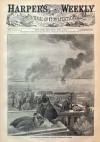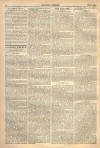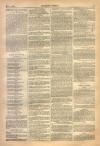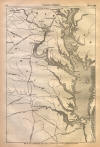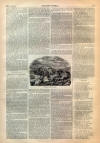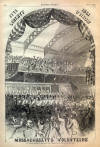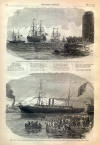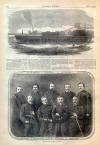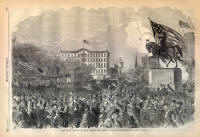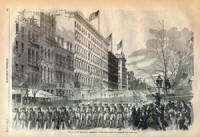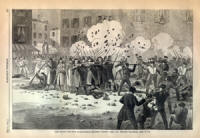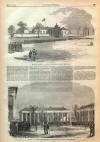News of the Battle of Baltimore
|
|
This Site:
|
MAY 4, 1861 .] HARPER'S WEEKLY. 279 haughty, do nothing and hold your tongue, consistently, and you will pass for an exceedingly well-bred person, and a superior being altogether. A poor gentleman's wife has much to bear, and I respect and love the home specimen when I see how well she goes through it all. What is the consequence of this ? My friend Jack Steadman—whom I have known ever since he was my fag at school-comes fidgeting into my chambers as I am writing this. He has come thus fidgeting about many times before. He had met the Virginia Saltifora, and was going to cut somebody's throat—probably the Honorable Coolman Flirtford's—because she did him out of that last gallop, or he was going through a course of strychnine and charcoal hot-air baths, because she would not look at him in the park. I soon got accustomed to such ebullitions. I used to give him one of my strongest cigars, and bid him sleep upon it—the blighted affection, I mean, not the cigar. He did, and smothered it. But now I see, by the expression of his countenance, that there is something serious the matter. With a shy sort of happy grin, he asks me if I remember the little girl with the big gray eyes that we met last July, at the Fizzeyman's picnic. I know what is coming. The little girl with the big gray eyes that we met at the Fizzeyman's picnic is an Anglicana Domestica of the most dangerous type. I remember calling upon her mother one day with Jack. The owner of the eyes was practicing in the back drawing-room, and Mr. Jack must needs go and turn over the music for her. I kept a sharp eye upon them while Materfamilias was recounting the horrible profligacy of her late cook. There sat the daughter in her simple morning dress, with natty little linen cuffs at her wrists and a natty little linen collar round her throat, a natty little belt round her natty little waist, and great wavy masses of glorious brown hair glistening in her natty little net. She had just concluded a piece; and, with one hand hanging on the keys, she looked up in Jack's face, while the chords were still quivering, and asked him how he liked "that." I never saw a girl look more "dangerous." I tell Jack that I do remember this person, and then, looking more shy and stupidly happy than before, he tells me that he is engaged to her, and " I say, old fellow, you know, you must be my best man." His best man ! Hang his impudence ! What else have I been to him all his life? And so roving Jack is led into captivity. Our acquaintance, the Virginia Saltifora, comes in state to the evening party that is given afterward to finish up the scraps of the wedding breakfast, and dances and flirts till she can hardly stand. But nothing comes of it, and the week afterward her cousin is heard of as about to sell out of the Guards, and settle down into matrimony with one of the bridemaids to the "little girl with the big gray eyes"—another specimen of the Anglicana Domestica that nobody heard of before. OUR WAR ILLUSTRATIONS.WE devote most of our space this week to the War. On page 273 will be found an interesting picture of the SCENE ON THE HOUSE-TOPS AT CHARLESTON during the bombardment of Fort Sumter. Reporters say that every human being in Charleston had gathered to see the fight. On page 276 we publish a MAP of that part of Virginia and Maryland which, for the present, promises to be the THEATRE OF THE WAR. It shows Baltimore and Harper's Ferry on the north, and Richmond and Norfolk on the south, with all the principal roads, railroads, canals, rivers, cities, etc. On page 277 will be found an engraving of the GREAT WAR MEETING in Union Square. Of this meeting the Herald said : " A great mass meeting in support of the Government, in the present crisis of the nation, was held at Union Square, in this city, on Saturday afternoon. Such a mighty uprising of the people has never before been witnessed in New York, nor throughout the whole length and breadth of the Union. Five stands were erected, from which some of the most able speakers of the city and State addressed the multitude on the necessity of rallying around the flag of the republic in this hour of its danger. A series of resolutions was proposed and unanimously adopted, pledging the meeting to use every means to preserve the Union intact and inviolate, and agreeing to the appointment of a committee of twenty-five, to represent the citizens in the collection of funds and the transaction of such other business in aid of the Government as the public interests may require. Great unanimity prevailed throughout the whole proceedings; party politics were ignored, and the entire meeting—speakers and listeners—were a unit in maintaining the national honor unsullied. Major Anderson, the hero of Fort Sumter, was present, and showed himself at the several stands, at each of which he was most enthusiastically received. An impressive feature of the occasion was the flag of Fort Sumter, hoisted on the stump of the staff that had been shot away by the revolutionists, and which was placed in the hand of the equestrian statue of Washington." On this page we give a small picture of HARPER'S FERRY, showing the Arsenal and Workshops which were destroyed by the United States troops to prevent them falling into the hands of the Virginians. Of this spot a correspondent wrote us some time since: "Harper's Ferry is situated in Jefferson County, Virginia, at the confluence of the Potomac and Shenandoah rivers, on a point just opposite the gap through which the united streams pass the Blue Ridge on their way toward the ocean. The Ridge here is about twelve hundred feet in height, shelving bare, precipitous cliffs on either side on the river, and exhibiting some of the most beautiful and imposing natural scenery to be found in the country. The town was originally built in two streets stretching along a narrow shelf between the base of the bluff and the rivers, meeting at the point at nearly a right angle, and named respectively Potomac and Shenandoah streets. To accommodate its increasing population the town has straggled up the steep bluff, and, in detached villages and scattered residences, occupies the level ground above—about four hundred feet above the streams. " It has altogether a population of five thousand ; is distant from Richmond 173 miles; from Washington City, 57 miles by turnpike road ; and from Baltimore, 80 miles by rail. Here the Baltimore and Ohio Railroad crosses the Potomac by a magnificent covered bridge, 900 feet long, and passes along Potomac Street westward, its track lying 40 feet above the river. The Winchester and Harper's Ferry Railroad, lying along Shenandoah Street, con- nects with the Baltimore and Ohio at the bridge. Potomac Street is entirely occupied by the workshops and offices of the National Armory, and its entrance is inclosed by a handsome gate and iron railing. Nearly at the angle of junction are the old arsenal buildings, where usually from 100,000 to 200,000 stand of arms are stored. The other buildings on the point, and nearer the bridge, are railroad offices, hotels, eating houses, stores, shops, etc. Shenandoah Street contains stores and dwelling-houses for half a mile or more, when we come to Hall's rifleworks, situated on a small island in the Shenandoah River." On page 280 we publish a picture of the MASSACHUSETTS REGIMENT (8th) EMBARKING IN THE JERSEY CITY CARS FOR WASHINGTON. A reporter of the Herald thus described the scene : " The ferry-boat with the troops on board reached Jersey City about twenty minutes before two. Long before their arrival hundreds congregated about the ferry and railroad depot waiting anxiously their arrival. The railroad depot was crowded with ladies, who filled the balconies which extend around the building, nearly every one bearing the Stars and Stripes. The depot was also beautifully decorated with flags, presenting a most imposing appearance. As the troops neared Jersey City a salute was fired from the Long Dock, and the Cunard steamer Persia dipped her colors several times. A squad of police, under Captain Holmes, also crossed the river to tender their services to the Jersey City authorities during the stay of the troops at the depot. As soon as the boat had been made fast to the bridge, and the order given to forward, the band struck up the ' Star Spangled Banner,' which was accompanied by deafening cheers from the crowd in and about the depot. As they entered the railroad depot cheer after cheer broke forth, the ladies waving their handkerchiefs and flags, which lasted for nearly twenty minutes. " The train, numbering eighteen cars, and to which was attached the powerful locomotive ' Walcott,' was covered with flags, and in charge of Mr. J. W. Woodruff, Assistant Superintendent of the road. A little delay was occasioned on account of the crowd in the building blocking up the place; but the Chief of Police of Jersey City, with his men and Sheriff Francis, aided by the squad of New York police, soon cleared the way. During the time the troops were in waiting to embark on board they were continually cheered, and the ladies amused themselves by throwing to the soldiers their pocket handkerchiefs and little flags. The order being given, the several companies were marched to their respective cars, and in about half an hour they were all safely on board the train. "At one o'clock Colonel Jones informed Mr. Woodruff that all was ready, and the signal was immediately given for the train to start. The first movement of the locomotive brought out cheer after cheer, and as the train slowly glided out from the depot, the crowd kept up their cheers and waving of flags. Among the ladies could be seen several in tears, deeply affected at the scene; and one old gentleman cried like a child. When asked if he had any friends among the troops, he replied that he had not, but he felt as though every one who composed the little band were his own sons. There were quite a number of the New Jersey militia who accompanied the troops as far as Trenton." On page 281 will be found a fine engraving of the MARCH OF THE SEVENTH REGIMENT DOWN BROADWAY prior to their departure for Washington. The Herald thus sketched the scene : "With the band pitying the national airs and the regiment's quicksteps : with the police relieving each other by turns, in frantic efforts to clear a way for the soldiery; with the line broken by the crowd, which surged backward and forward like an ocean, the march began. Through a crowd so dense that it seemed to block up the way impassably. Through walls of human beings, close, compact, unshrinking, as if the police, like a modern Moses, had parted the sea of people into living walls. Under a perfect canopy of flags, gilded by the sun with a glory as bright as that which they have always won and deserved. With cheers rolling along like enthusiastic thunders. Past buildings whose fronts were covered with flags, and above doors, windows, stoops, and balconies were jammed with people. With handkerchiefs, waved by fair hands and as numerous as the forest-leaves which the winds rustle, saluting the gallant volunteers. Past Major Anderson, who reviewed the regiment from the balcony of Ball, Black,& Co.'s building, and by his presence reminded them of war's dangers and of its glories. Past an effigy of "Jeff Davis as he would be"—hung—and with the motto, " 'Jeff Davis, Jeff Davis, beware of the day, When the Seventh shall meet thee in battle array.' "Past mottoes more commendable and in better taste, declaring that the ' National Guard was for the Union,' and that its members should imitate the National Guard of 1776.' With bayonets, brightly glancing in the sun; with step firm; with bearing proud and erect, as befitted the men and the occasion, the Seventh regiment marched down Broadway. Never was a popular demonstration more brilliant and more enthusiastic. New York city is celebrated for her ovations, but even that to the Prince of Wales could not compare with this in its heartiness, its spontaneity, and its enthusiasm. The street, from Fourth to Courtlandt, was bright with the colors of our most beautiful flag, and the cheers were never remitted. All the people thronged to pay honor to the men who went to defend them, and lining the streets, crowding the Park, blockading up Chatham Street and clustering over the Museum, they looked, shouted, and cheered as they have seldom done before. The crowd parted for the soldiery to pass, but before and behind them appeared a dense, solid, impenetrable mass. Fire-engines were brought to the street-corners and jangled their bells as the Seventh passed. The buildings along Broadway are themselves a decoration, so variedly beautiful is their architecture, end so magnificent their proportions; but one accustomed to see only the everyday Broadway can form no idea of it as it appeared yesterday, flaunting with flags and packed with tier upon tier of people, from sidewalk to house-roof." On page 282 we illustrate the SAILING OF THE TRANSPORTS FROM NEW YORK, On Sunday, April 21, with Volunteers for the War. The Herald said : "The bay never appeared to more advantage than it did yesterday on the occasion of the departure of the transport fleet for Washington. From an early hour in the morning until sunset, yachts, sail-boats, and other smaller crafts, filled with the friends of the troops, dotted the entire surface of the North River, and hovered around the trans-ports until the very last moment. The ferry-boats and shipping were richly decorated with flags, and were crowded to their utmost capacity with an anxious multitude of men, women, and children. " At a quarter past five o'clock, all being in readiness on board the Baltic, the cables were slipped, and the vessel glided out gracefully into the stream, amidst the firing of cannon, the ringing of bells, and the hearty cheers of over fifty thousand spectators. Unlike the Cuyler the Baltic kept steadily on her course, and, heading for Staten Island, led the fleet on their voyage to the Capital. As she passed down the river, the Empire State, the Cuyler, the Coatzacoalcos, the Columbia, and other vessels dipped their colors, while steamboats blew their fog-whistles and rang their bells in honor of the occasion. The Harriet Lane, Captain Faunce, accompanied the Baltic down the bay, and led her all the way to Quarantine. The Cutler soon followed in the wake of the Baltic, and then the Coatzacoalcos, Columbia, and Empire State fell in behind, and at half past six o'clock the entire fleet was under way. All along the line of the North River, reaching from Fourteenth Street to the Battery, the piers were jammed with spectators, and as the transports, one by one, hauled out into the stream, there was a rush for the lower end of the city which carried every thing before it. As the dense mass forced its way along West Street, the very houses shook to their foundations with the concussion. On the water the people were equally excited, and the most frantic efforts were made to keep pace with the transports. Oarsmen strained every nerve to be with the volunteers as long as they could, but after a few minutes' vigorous pulling gave up the job in despair, and contented themselves with waving their handkerchiefs and cheering until their forms were no longer discernible to their friends on board the fast receding fleet." On page 283 we publish an illustration of the FIRST BLOOD—viz., the conflict between the Baltimore mob and the Massachusetts regiment on 19th April. The Baltimore Sun of April 20 says : " Yesterday morning the excitement which had been gradually rising in this city for some days, with reference to the passage of Northern volunteer troops southward, reached its climax upon the arrival of the Massachusetts and other volunteers, some from Philadelphia, at President Street depot, at half past ten o'clock. A large crowd had assembled, evidently to give them an unwelcome reception. " Six of the cars had succeeded in passing on their way before the crowd were able to accomplish their purpose of barricading the track, which they now began to effect by placing large, heavy anchors, lying in the vicinity, directly across the rails. Some seven or eight were borne by the crowd and laid on the track, and thus the passage of the cars was effectually interrupted. "Having accomplished this object, the crowd set to lustily cheering for the South, for Jefferson Davis, South Carolina, and secession, and groans for sundry obnoxious parties. In the mean while, the troops thus delayed at the depot remained quietly in the cars until tired of their inaction, and apprehending a more formidable demonstration, they came to the conclusion to face the music and march through the city. "They accordingly evacuated the cars, and rapidly gathering on the street north of the depot, formed in line and prepared to make the attempt. The word was given to 'march,' and the head of the line had advanced some fifteen paces, when it was driven back upon the main body by the immense crowd, still further increased by a body of men who marched down to the depot bearing at their head a Confederate flag. " Eight of the cars started from the President Street depot, and six passed safely to the Camden station. The other two soon returned, the track in the mean time having been obstructed at the corner of Pratt and Gay streets by anchors, paving stones, sand, etc., being put on it by the crowd. Attempts had previously been made to tear up the track, but the police by strenuous efforts prevented it. A cart-load of sand, which was being driven along, was seized and thrown upon the track. " After considerable delay it was determined to make the attempt to march the remaining troops through the city, only about sixty of whom were supplied with arms. The remainder were recruits, and occupied second-class and baggage cars. "At the head of this column on foot, Mayor Brown placed himself, and walked in front, exerting all his influence to preserve peace. "Just before the movement was made from the cars a large crowd of persons went down President Street with a Southern flag and met the troops as they emerged from the cars. The Southern flag was then carried in front of the column, and hooting and yelling began, and as soon as the troops turned out of Canton Avenue they were greeted with a volley of stones. "At the corner of Fawn Street two of the soldiers were struck with stones and knocked down; one of them was taken by the police to the drug store of T. J. Pitt, at the corner of Pratt and High streets, and the other to the eastern police station. "The yelling continued, and the stones flew thick and fast. At Pratt Street bridge a gun was fired, said by policeman No. 71 to have been fired from the ranks of the soldiers. Then the crowd pressed stronger, until the body reached the corner of Gay Street, where the troops presented arms and fired. Several persons fell on the first round, and the crowd became furious. A number of revolvers were used, and their shots took effect in the ranks. People then ran in every direction in search of arms, but the armories of the military companies of the city were closely guarded and none could be obtained. The firing continued from Frederick Street to South Street in quick succession, but how many fell can not now be ascertained. "From Gay to South Street, on Pratt, the fight with the soldiers who marched, or rather ran, through the town, was terrific. Large paving stones were hurled into the ranks from every direction, the negroes who were about the wharf in many instances joining in the assault. At Gay Street the soldiers fired a number of shots, though without hitting any one, so far as could be ascertained. After firing this volley the soldiers again broke into a run, but another shower of stones being hurled into the rank at Commerce Street with such force as to knock several of them down, the order was given to another portion of them to halt and fire, which had to be repeated before they could be brought to a halt. They then wheeled and fired some twenty shots, but from their stooping and dodging to avoid the stones, but four or five shots took effect, the marks of a greater portion of their balls being visible on the walls of the adjacent warehouses, even up to the second stories. Here four citizens fell, two of whom died in a few moments and the other two were carried off, supposed to be mortally wounded. "As one of the soldiers fired he was struck with a stone and knocked down, and as he attempted to rise another stone struck him in the face, when he crawled into a store, and prostrating himself on the floor, clasped his hands and begged piteously for his life, saying that he was threatened with instant death by his officers if he refused to accompany them. He said one half of them had been forced to come in the same manner, and he hoped all who forced others to come might be killed before they got through the city. He plead so hard that no further vengeance was bestowed upon him, and he was taken to the police station to have his wounds dressed. As soon as they had fired at this point they again wheeled and started off in a full run, when some three or four parties issued from the warehouses there and fired into them, which brought down three more soldiers, one of whom was carried into the same store with the one above alluded to, and died in a few moments. The others succeeded in regaining their feet, and proceeded on with their comrades, the whole running as fast as they could, and a running fire was kept up by the soldiers from this point to the depot, the crowd continuing to hurl stones into the ranks throughout the whole line of march." On page 284 we publish the group of Major Anderson's officers at Fort Sumter—THE HEROES OF SUMTER—whose biographies have been heretofore given in Harper's Weekly. We publish on page 285 two pictures of the INSPECTION OF UNITED STATES TROOPS ON GOVERNOR'S ISLAND, NEW YORK HARBOR. Every day from twenty-five to fifty men arrive at Governor's Island from the various recruiting offices in New York and elsewhere, and are immediately drilled in squads, until they are fit to be formed into companies and drafted into regiments. Every afternoon the troops are marched out upon the grassy slope to the rear of the southeastern battery, and are drilled in every conceivable movement for the space of about one hour, and the success of this rigid training is to be very satisfactorily observed in the precision and rapidity of execution following any given order. A staff of officers usually occupy the rising ground. Before the departure of the late expedition for Charleston not less than seven or eight hundred men, with army and knapsacks complete, were rallied in line behind the grove of trees ornamenting the southeastern battery. After going through various evolutions, part of the troops were separated and marched past the officers' houses to the water's edge. Of the recruits on the Island it may be said that their ease and precision of movement, as well as their numbers when all together, render their appearance quite formidable, and they look like a little army. Their officers, too, show indications of being able military men. MOVING.THE first of May is nearly come, And people think of moving; The cart and truck and wagon men Find business improving; All kinds of costly furniture The brawny fellows lash on- I think I'll move some things myself, And so be in the fashion. I've got a curious sort of house, Which never had a number; From top to bottom it is filled With lots of useless lumber.
And though I live a bachelor,.
But night and day, and day and night, Is given up to riot.
This curious house is called a
heart,
Some chambers are as bright as day, But some are very gloomy. And there are pictures on the walls—Some beautiful and sainted, And some that I regret to say Should never have been painted. Some rooms are scented all with flowers And memories of my childhood The boyish days of innocence, The river, and the wild-wood. And one is haunted by a face More beauteous than all others; And my hard face grows young again When gazing on my mother's. But yet, alas ! in many a room Still hang the scents of revel, When fellows made for better things Sank down to toper's level.
And there are old, revolting
jests
With fragments of the prurient songs That waked the drunkard's laughter. So now to clear all these away! Come, Virtue, bring your besom;
We'll sweep the vile things out
of door,
And when my house is sweet and clean As you and I can make it, I think I know a pretty girl Who won't object to take it. HARPER'S FERRY, VIRGINIA.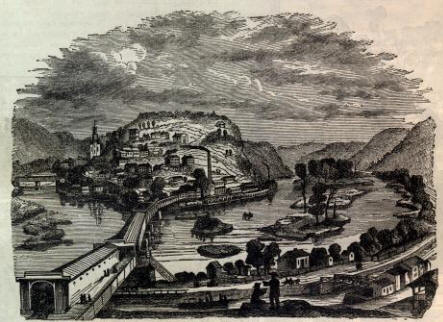 |
|||||||||||||||||||||||||||
|
|
||
|
|
Site Copyright 2003-2018 Son of the South. For Questions or comments about this collection, contact: paul@sonofthesouth.net |
|
|
Are you Scared and Confused? Read My Snake Story, a story of hope and encouragement, to help you face your fears. |
||
